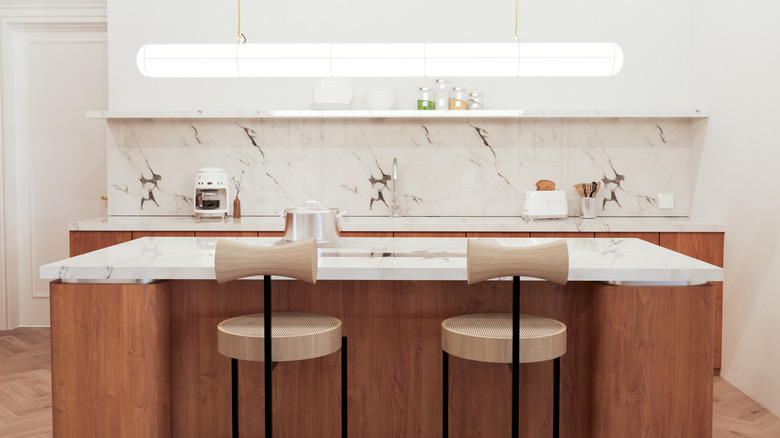Give Your Kitchen Island Huge Style Points With A Waterfall Look
Kitchens have long been referred to as the "heart" of a home for good reason. It's a gathering space, a teaching space, and somewhere that tiny hands grasp tiny whisks and recipes are passed down over generations. We all decorate and design our spaces differently, so while you might opt for a movable butcher block (a way to extend your kitchen island while also adding a useful bonus), someone else might prefer no kitchen island at all. Or there's always waterfall countertops, the latest design trend taking the home renovation world by storm.
A waterfall countertop is a design that entails extending the material of an island countertop all the way to the floor, creating a look quite literally reminiscent of a waterfall. While most kitchen islands feature a slab of granite or stone on top and wooden sides connecting to the floor, the idea here is that the island's material flows from top to bottom. It's meant to look like one continuous piece, even though it's fairly common that the edges of these waterfall countertops are squared. It's a rather dramatic addition to a kitchen, so if you're looking to gain huge style points and upgrade your space with a modern, luxury vibe, this might be right up your alley. Or, if you need more time to think, here's how to choose the perfect kitchen island for your space, according to two experts.
Waterfall countertops bring Art Deco to the 21st century with a modern twist
Although it's had a comeback in the last few years, the waterfall countertop has been around for at least a decade or two, drawing inspiration from the Art Deco era. Between the 1920s and 1940s, Art Deco furniture popularized waterfall edges, furniture with smooth, continuous edges. Just about 100 years later, it's clear the style never died, only evolved. When adding a waterfall countertop to a kitchen island, some people choose to have a single dropped-down side while others opt for a double-ended waterfall, depending on both practicality and need for dramatic emphasis.
Most waterfall countertops are made from stones such as granite, marble, or quartz, though wood and concrete are always viable options, too. If you're opting for a natural stone, creating the seamless waterfall effect will require some serious precision, since the whole goal is to make it look like a never-ending slab of stone with intricate patterns lining up, even at the edge. Another potential drawback to waterfall countertops is price. Certain materials can get pricey, especially when you have to purchase extra for the waterfall effect, but it can be worth it if you're hoping for a kitchen island upgrade. While a waterfall countertop conveys a more contemporary design choice, there are still ways to mix modern and vintage styles in your kitchen to achieve the perfect blend for the space you've always dreamed of.

